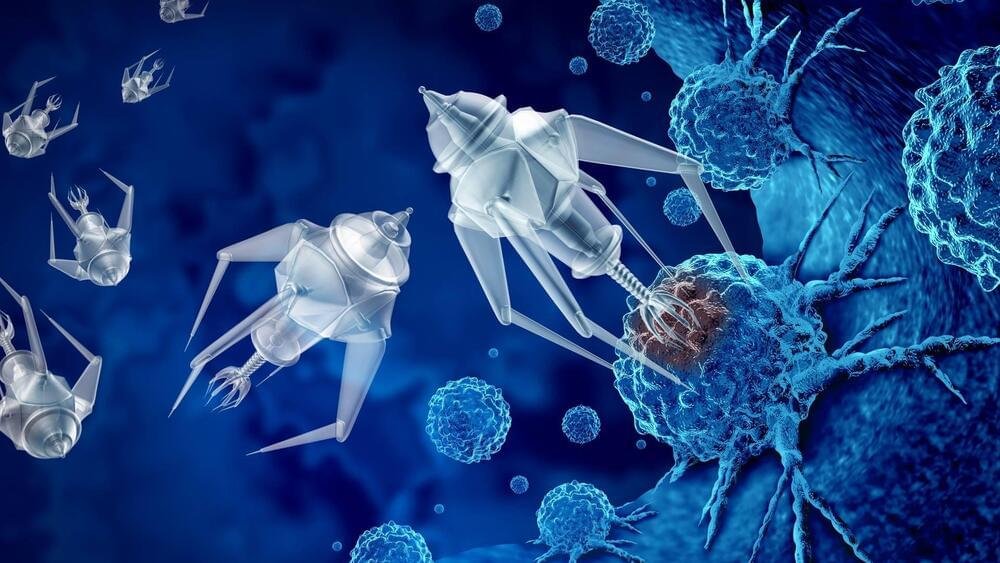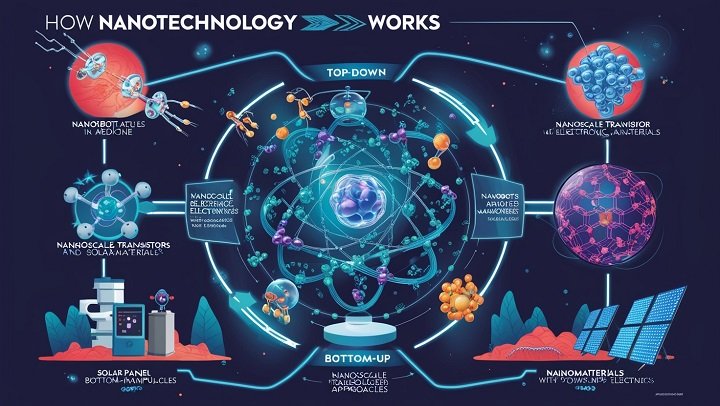How Does Nanotechnology Work? is one of the coolest and most advanced fields of science today. It’s not just a concept from science fiction movies anymore—it’s real, and it’s changing the world in ways we might not even realize. But what exactly is nanotechnology, and how does it work? Let’s dive into this fascinating topic and break it down into simple, easy-to-understand terms.
What Is Nanotechnology? How Does Nanotechnology Work?

To give you a sense of how tiny this is, imagine this: A single sheet of paper is around 100,000 nanometers thick! Nanotechnology is the science and engineering of working with materials, particles, and devices at the nanoscale. By controlling materials at such a small size, scientists and engineers can create new materials and devices with incredible properties and capabilities.
Why Is Nanotechnology Important?
Nanotechnology is a big deal because when materials are that small, they start behaving differently than they do on a larger scale. Things like electricity, magnetism, and chemical reactions can change dramatically when you shrink things down to the Nano level. This allows scientists to design materials and products that are stronger, lighter, more efficient, and even more environmentally friendly.
Nanotechnology plays a role in many industries, including:
- Medicine
- Energy
- Electronics
- Environmental Science
- Food and Agriculture
Now that we know what nanotechnology is, let’s explore how it actually works.
How Does Nanotechnology Work?
Nanotechnology works by manipulating materials at the atomic or molecular level. To put it simply, it’s like building with really tiny building blocks, only these blocks are atoms and molecules. Scientists and engineers work with these tiny components to create new materials, devices, or systems that have unique properties.
There are two main approaches to nanotechnology: the top-down approach and the bottom-up approach. Let’s break them down:
1. Top-Down Approach
The top-down approach is like carving a statue out of a block of stone. Scientists start with a larger material and then gradually remove parts of it to create something at the nanoscale.
For example, in nanolithography, a top-down approach, light or another form of radiation is used to etch patterns into a surface. This helps create circuits that are smaller, faster, and more efficient.
2. Bottom-Up Approach of How Does Nanotechnology Work?
The bottom-up approach is more like building a house, where you start by putting together individual bricks (or in this case, atoms and molecules) and work your way up. In this approach, scientists encourage atoms or molecules to assemble themselves into desired structures or shapes.
For example, in the field of drug delivery, researchers are developing tiny particles that can carry medicine directly to the cells that need it, helping to treat diseases more effectively.
The Science Behind Nanotechnology
At the heart of nanotechnology are three scientific principles that make it all possible: quantum mechanics, surface area, and self-assembly.
Quantum Mechanics
When we start dealing with materials at the nanoscale, quantum mechanics comes into play. This branch of physics explains how things behave on the smallest scales, where the rules of classical physics don’t always apply.
For example, when particles become extremely small, their optical (how they reflect or absorb light), electrical, and magnetic properties change. That’s why gold nanoparticles can appear red instead of the usual gold color. Quantum mechanics helps scientists predict and control these new properties, allowing for groundbreaking innovations in electronics, medicine, and more.
Surface Area to Volume Ratio of How Does Nanotechnology Work?
One of the reasons nanomaterials are so special is that as objects get smaller, their surface area increases relative to their volume. A larger surface area means more space for chemical reactions to happen, which can make nanomaterials incredibly reactive.
This is especially useful in catalysis, where nanomaterials are used to speed up chemical reactions in industries like fuel production or environmental cleanup. Nanoparticles can also be used in products like sunscreens to provide better UV protection or in paints that are more durable.
Self-Assembly
Remember the bottom-up approach we talked about earlier? It often relies on something called self-assembly, where molecules naturally arrange themselves into organized structures without needing human intervention.
Scientists can tweak the conditions, like temperature or chemical environment, to control how the molecules come together.
Applications of Nanotechnology
How Does Nanotechnology Work? now that we understand how nanotechnology works, let’s explore some of the amazing ways it’s being used today.
Medicine
Nanotechnology is revolutionizing healthcare. Scientists are developing nanobots, tiny machines that can enter the human body to repair tissues or deliver medicine exactly where it’s needed. Nanoparticles are also being used in cancer treatments, where they can target and kill cancer cells while leaving healthy cells unharmed.
For example, liposomes (tiny spherical vesicles made of lipid bilayers) are being used to deliver drugs directly to the site of tumors, improving the effectiveness of chemotherapy with fewer side effects.
Electronics
If you’re reading this on a computer, smartphone, or tablet, you’re benefiting from nanotechnology! Transistors in computer chips are now built at the nanoscale, allowing for faster and more powerful electronics. As these chips get smaller and smaller, we can expect to see even more advanced gadgets in the future.
Energy
Nanotechnology is helping create more efficient and sustainable energy solutions. For instance, solar panels made with nanomaterials are more efficient at converting sunlight into electricity.
Challenges and Future of How Does Nanotechnology Work?

As the field continues to grow, we’ll likely see even more innovations in medicine, energy, and beyond.
For those curious about more in-depth studies on the risks and rewards of nanotechnology, you can check out a detailed study from which explores the safety aspects of working with nanomaterials.
Conclusion
Nanotechnology might sound complex, but at its core, it’s all about working with materials at an extremely small scale to create new and amazing things. From medicine and electronics to energy and environmental solutions, nanotechnology is already changing the world—and the possibilities for the future are limitless.
To learn more about the ongoing developments in nanotechnology, check out this informative resource from for the latest research and breakthroughs in the field.
In the coming years, we can expect to see even more incredible advancements in nanotechnology, transforming industries and improving our lives in ways we can’t even imagine yet.




